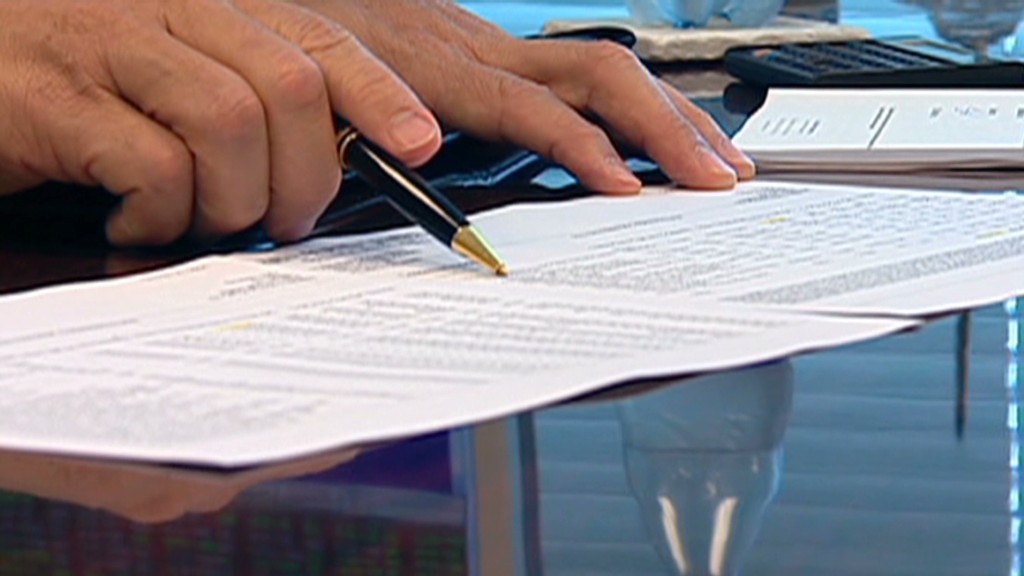When it comes to keeping New Year's resolutions, the bulls on Wall Street have outdone themselves.
The S&P 500 was supposed to finish the year at 1,490, according to CNNMoney's survey of more than 30 investment strategists in December. After a big move in January, it's already firmly above 1,500.
The 5% gain in January was the best start to a year for S&P 500 since 1997. If it continued at that near-impossible rate, the index would log a full-year return of 78.5%, said Mark Luschini, chief investment strategist at Janney Montgomery Scott.
"Needless to say, this performance begs the question as to whether this pace is sustainable," said Luschini.
Investors rushed into stocks last month after officials in Washington reached a deal on the fiscal cliff.
The rally, which pushed stocks near all-time highs, coincided with record inflows into stock-based mutual funds, as individual investors regained some appetite for risk after shunning stocks for years.
But the bullish tone has already started to fade.
"We're certainly off to a great start," said Jack Ablin, chief investment officer at BMO Private Bank. "But we may have gotten a little ahead of ourselves."
Most don't expect a textbook stock market correction, when major gauges drop 10% from their most recent highs. But a pause or pullback of some sort is increasingly likely.
"We've had a dramatic rally, and it needs to be corrected. But that doesn't mean the market has to go down," said Dan Greenhaus, market strategist at BTIG. "I'd be surprised to see a big move one way or the other."
Much will depend on the economy.
The improved data late last year may have been distorted by accelerated dividend payments ahead of the looming fiscal cliff, as well as increased purchases of cars and furniture following Hurricane Sandy, said Ablin.
And consumer spending, which has been surprisingly strong, could take a hit as the payroll tax increase eats into households' take home pay, say Barclays analysts.

The latest data on the job market has also been relatively weak.
Meanwhile, there are renewed concerns about Europe, with political uncertainty hanging over Spain and Italy. And the fiscal problems in the United States could be back in the headlines as the March deadline for automatic spending cuts approaches.
Despite these potential landmines, stocks continue to flirt with record highs as the bull market appears to be near its peak.
So far in February, the S&P 500 has gained just over 1%. That's on top of last month's advance, and last year's 13.4% jump.
The long-term surge has been largely driven by the Federal Reserve's stimulus policies, specifically the central bank's $2 trillion bond buying program.
The Fed is not expected to take its foot off the gas anytime soon, and that should help put a floor under stocks, say analysts.
Related: M&A making a comeback
While corporate earnings growth has helped draw investors back in, that may not last.
In the fourth quarter, earnings for S&P 500 companies largely beat analysts' modest expectations. But nearly 70% of those that have issued guidance so far have had a negative outlook for the first quarter, according to S&P Capital IQ.
Still, stocks could continue to find support as investors who missed the rally "chase the market higher," said Scott Wren, senior equity strategist at Wells Fargo Advisors.
With returns on more conservative investments yielding almost nothing, Wren said investors nearing retirement age have been increasingly willing to put money into stocks, particularly those that pay healthy dividends, such as AT&T (T), General Electric (GE) and McDonalds (MCD).
"They are starting to throw caution to the wind and jump in," he said.
And with calls for a correction growing louder, Wren said that may be enough for it not to happen.
"When everybody is waiting for a pullback, at least in the near term, it usually doesn't happen," he said.



